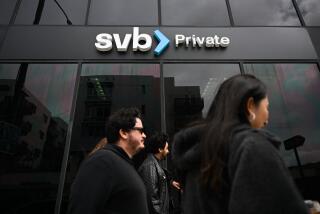Regulators Begin Drafting Subprime-Loan Guidelines
- Share via
WASHINGTON — Federal regulators are moving to establish rules for high-risk lending by banks and thrifts, and examiners are keeping a sharp eye on troubled institutions, the head of the government’s thrift agency said Thursday.
The rules might have prevented the failure of Superior Bank, a $1.8-billion thrift in the Chicago area battered by huge losses on mortgage loans to high-risk borrowers. The thrift was seized by federal regulators July 27 and is operating under government control.
The collapse of Superior, which is half-owned by the multibillionaire Pritzker family, is expected to cost the federal insurance fund an estimated $500 million, which would make it one of the costliest failures of a U.S. financial institution.
Ellen Seidman, director of the federal Office of Thrift Supervision--which made the decision to close Superior--said its failure had little effect on the performance of the thrift industry, which was boosted by the strong housing market and earned a record $2.5 billion in the April-June period.
“It is a very small part of an industry that, on the whole, is doing quite well,” Seidman said during her first meeting with reporters since the Superior takeover. She rejected criticism from some banking experts that her agency acted too slowly to resolve the thrift’s problems.
Seidman has been called by the Senate Banking Committee to testify at a hearing on the Superior debacle Tuesday, and she declined to discuss the matter in any detail Thursday.
Regulators are taking a harder look at banks and thrifts that are heavily involved in such lending to borrowers with blemished credit histories, known as “subprime” lending. While many of the institutions are making big profits on those loans, they’re more likely to find themselves in trouble than others.
The rules drafted by the federal bank regulatory agencies--the thrift agency, the Federal Reserve, the Federal Deposit Insurance Corp., the Treasury Department’s Office of the Comptroller of the Currency and the National Credit Union Administration--are expected to be out before year’s end.
“This is an industry of risk-taking,” Seidman said, adding that federal examiners are closely watching banks and thrifts to ensure the risks they assume are reasonable.
Like many other banks and thrifts, Superior bundled its high-risk home and car loans into securities for resale to investors. The thrift diluted the risk by packaging the loans together and paid a correspondingly lower interest rate to the investors than what it charged the borrowers with weak credit, recording the difference between the two rates as a profit on its books.
The new rules would require banks and thrifts to limit those profits, known as residuals, to 25% or less of their total primary capital.
On Wednesday, FDIC Chairman Donald Powell said that his agency--which now controls Superior--is closely watching banks that engage in subprime lending, but that additional failures are not anticipated.
The FDIC also reported that the nation’s commercial banks wrote off $2.8 billion in credit card debt in the second quarter, up nearly 27% from a year earlier, as the economy dragged and personal bankruptcy filings rose.
“We’re not seeing a general downturn in banking,” Powell said. “They’re still earning a lot of money.”
Banks earned $19.2 billion in the second quarter, down 4% from record-high profits of $19.9 billion in the first three months of the year, but up 31% from $14.6 billion in the second quarter of 2000, the preliminary results showed.
More to Read
Inside the business of entertainment
The Wide Shot brings you news, analysis and insights on everything from streaming wars to production — and what it all means for the future.
You may occasionally receive promotional content from the Los Angeles Times.










